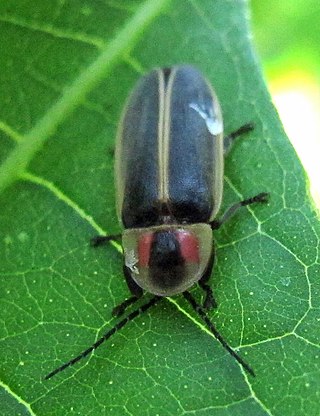
Photinus pyralis, also known by the common names the common eastern firefly or big dipper firefly, and sometimes called a "lightning bug", is a species of flying beetle. An organ on its abdomen is responsible for its light production. It is the most common species of firefly in North America, and is typically found east of the Rocky Mountains. Photinus fireflies are often confused with fireflies of the similar-sounding genus, Photuris, which are also found in North America.

The rover fireflies (Photinus) are a genus of fireflies. They are the type genus of tribe Photinini in subfamily Lampyrinae. This genus contains, for example, the common eastern firefly, the most common species of firefly in North America.

Photinus carolinus, commonly known as the Smokies synchronous firefly, is a species of rover firefly whose mating displays of synchronous flashing have fascinated both scientists and tourists. As individual females synchronize with males nearby, waves of alternating bright light and darkness seem to travel across the landscape. Firefly displays typically occur in early June near Elkmont, Tennessee, in the Great Smoky Mountains National Park, near Gatlinburg. The species can be found in isolated pockets of the Appalachian Mountains in the eastern United States.
Photinus consanguineus, or double cousin firefly, is a species of firefly in the genus Photinus. It is found in eastern North America.
Photinus macdermotti, or Father Mac's firefly or Mr. Mac, is a species of firefly in the family Lampyridae. It is found in North America.
Photinus brimleyi, or sidewinder firefly is a species of firefly in the Photinus genus. It is found in the southeastern United States.

Photinus sabulosus is a species of firefly in the beetle family Lampyridae. It is found in North America.
Photinus ardens is a species of firefly in the beetle family Lampyridae. It is found in North America.

Photinus marginellus is a species of firefly in the beetle family Lampyridae. It is found in North America.
Photinus cookii, or Cook's firefly is a species of day-active firefly in the beetle family Lampyridae. It is found in North America in the Eastern USA, including Florida and Texas.
Photinus concisus is a species of firefly in the beetle family Lampyridae. It is found in Kerrville, Texas. It the species most closely related to Photinus pyralis.
Photinus ignitus is a species of firefly in the beetle family Lampyridae. It is found in North America.
Photinus collustrans is a species of firefly in the beetle family Lampyridae. It is found in North America.

Photinus indictus, or silent firefly, is a species of firefly in the beetle family Lampyridae. It is a diurnal firefly, active during the day rather than at night, with no lanterns. It is found in eastern North America.
Photinus knulli is a species of firefly in the beetle family Lampyridae. It is found in North America.
Photinus tenuicinctus, or thinly-girdled firefly or Ozark spark, is a species of firefly in the beetle family Lampyridae. It is found in the Ozarks in Arkansas and Oklahoma.
Photinus punctulatus is a species of firefly in the beetle family Lampyridae. It is found in North America.
Photinus obscurellus is a species of firefly in the family Lampyridae. It is found in North America.
Photinus immaculatus is a species of firefly in the beetle family Lampyridae. It is found in North America.
Photinus texanus is a species of firefly in the beetle family Lampyridae. It is found in North America.







